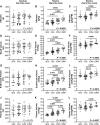The effect of chronic habitual exercise on oxygen carrying capacity and blood compartment volumes in older adults
- PMID: 38420680
- PMCID: PMC11305637
- DOI: 10.1152/japplphysiol.00706.2023
The effect of chronic habitual exercise on oxygen carrying capacity and blood compartment volumes in older adults
Abstract
Absolute total hemoglobin mass (tHbmass) and blood compartment volumes are often considered to be higher in endurance athletes compared with nonathletes, yet little data support a fitness effect in older age. Therefore, we measured tHbmass and blood compartment volumes (carbon monoxide rebreathing) in 77 healthy individuals (23% female; aged, 60-87 yr). Participants were recruited into groups based upon their lifelong (>25 yr) exercise "dose": 1) 15 sedentary individuals, <2 sessions/wk; 2) 25 casual exercisers, 2-3 sessions/wk; 3) 24 committed exercisers, 4-5 sessions/wk; and 4) 13 competitive Masters athletes, 6-7 sessions/wk, plus regular competitions. Absolute (L/min) and relative (mL/kg/min) V̇o2peak were higher with increasing exercise "dose" (P = 0.0005 and P < 0.0001, respectively). Hemoglobin concentration, hematocrit, and absolute tHbmass and blood compartment volumes were not significantly different between groups (all, P > 0.1328). When scaled to body mass, tHbmass (Sedentary, 9.2 ± 1.7 mL/kg; Casual, 9.2 ± 1.3; Committed, 10.2 ± 1.4; Competitive, 11.5 ± 1.4, ANOVA P < 0.0001) and blood volume were significantly different between groups [Sedentary, 63.4 (59.2-68.5) mL/kg; Casual, 67.3 (64.4-72.6); Committed, 73.5 (67.5-80.2); Competitive, 83.4 (78.9-88.6), ANOVA P < 0.0001], whereby all values were highest in Masters athletes. However, when scaled to fat-free mass (FFM), tHbmass and blood compartment volumes were greater in Competitive compared with Casual exercisers (all, P < 0.0340) and tHbmass and erythrocyte volume were also higher in Committed compared with Casual exercisers (both, P < 0.0134). In conclusion, absolute tHbmass and blood compartment volumes are not different between groups, with dose-dependent differences only among exercisers when scaled for FFM, with the highest tHbmass and blood compartment volumes in competitive Masters athletes.NEW & NOTEWORTHY We observed that absolute oxygen carrying capacity (total hemoglobin mass, tHbmass) and blood compartment volumes were not associated with lifelong exercise dose. However, hematological adaptations associated with lifelong habitual exercise are only present among exercisers, whereby competitive Masters athletes have a greater oxygen carrying capacity (tHbmass) and expanded blood compartment volumes when scaled to fat-free mass.
Keywords: blood volume; habitual exercise; hemoglobin; oxygen carrying capacity; oxygen uptake.
Conflict of interest statement
No conflicts of interest, financial or otherwise, are declared by the authors.
Figures




Similar articles
-
The effect of lifelong exercise dose on cardiovascular function during exercise.J Appl Physiol (1985). 2014 Apr 1;116(7):736-45. doi: 10.1152/japplphysiol.00342.2013. Epub 2014 Jan 23. J Appl Physiol (1985). 2014. PMID: 24458750 Free PMC article.
-
Impact of lifelong exercise "dose" on left ventricular compliance and distensibility.J Am Coll Cardiol. 2014 Sep 23;64(12):1257-66. doi: 10.1016/j.jacc.2014.03.062. J Am Coll Cardiol. 2014. PMID: 25236519 Free PMC article.
-
Hemoglobin Mass and Blood Volume in Swimming: A Comparison Between Highly Trained, Elite, and World-Class Swimmers.Int J Sports Physiol Perform. 2023 Aug 29;18(11):1357-1361. doi: 10.1123/ijspp.2023-0133. Print 2023 Nov 1. Int J Sports Physiol Perform. 2023. PMID: 37643755
-
Invited Review: Dynamic exercise performance in Masters athletes: insight into the effects of primary human aging on physiological functional capacity.J Appl Physiol (1985). 2003 Nov;95(5):2152-62. doi: 10.1152/japplphysiol.00320.2003. J Appl Physiol (1985). 2003. PMID: 14555676 Review.
-
Lifelong Endurance Exercise as a Countermeasure Against Age-Related Decline: Physiological Overview and Insights from Masters Athletes.Sports Med. 2020 Apr;50(4):703-716. doi: 10.1007/s40279-019-01252-0. Sports Med. 2020. PMID: 31873927 Review.
References
MeSH terms
Substances
Grants and funding
LinkOut - more resources
Full Text Sources
Medical

